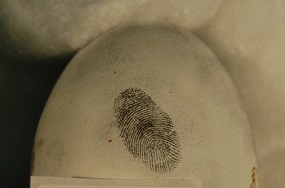In the news

Abertay University create world's first ever feather fingerprint technology to help tackle wildlife crime
14 Jan 2015
 Forensic scientists at Abertay University have identified the most efficient way of recovering fingerprints from the feathers and eggs of birds of prey, publishing the world’s first academic research paper on the subject.
Forensic scientists at Abertay University have identified the most efficient way of recovering fingerprints from the feathers and eggs of birds of prey, publishing the world’s first academic research paper on the subject.
Although there has been anecdotal evidence of fingerprints being recovered from feathers before, this is the first time that a tried and tested method looking specifically at birds of prey has been established and the results published.
In the UK all wild birds, their nests and their eggs are protected by law. However, wildlife crime is on the rise: since 2006, 2,578 incidents of bird crime involving or targeting wild birds of prey have been reported to the RSPB.
Shooting, poisoning and trapping are the most frequent methods used.
Additionally - despite the illegal collection of the eggs of birds of prey being in decline - the practice continues.
Although there is a perception among the general public that fingermarks are being superseded by DNA, the Home Office Centre for Applied Science and Technology reports that they still account for more identifications overall and show no signs of being phased from use.
Indeed, when it comes to wildlife crime, they may actually be the main link between the suspect and the crime.
Dennis Gentles – a former scenes of crime officer and forensic scientist who is now a lecturer in forensic science at Abertay - explains:
“There are some surfaces where recovering fingerprints remains elusive - human and animal skin, for example. And, until now, feathers were on that list.
“We had heard anecdotally that it had been achieved, and were keen to see if we could develop a method that produced consistent results and could be used by the police in an investigation.
“So, what we have done is establish which fingerprint powders would be most effective at developing fingermarks on the flight feathers of birds of prey.
“It had not been established which of the many different fingerprint powders available would work before and, although they would have been examined using one form of fingerprint development, there was always a risk of damaging the evidence and, as a consequence, wasting time and effort.
“Now, if the police examine a discarded bird of prey for fingerprints following our guidelines, any fingermarks that have been left there will become visible.
“If a finger mark shows up, it is proof that the bird has been handled, and suggests that it was discarded on someone else’s land as the perpetrator tried to get rid of the carcass.
“Even if they don’t manage to recover an identifiable fingermark, the presence of the mark means that they know exactly where to focus their attention to swab for DNA and that this particular bird of prey had been handled by a human.
“So we hope that this research will help the police in their endeavours to bring those guilty of wildlife crime to justice. They will now be able to recover more evidence – and it will be evidence that could potentially link a suspect to the crime.”
Ian Thomson, Head of Investigations at RSPB Scotland, welcomed this research:
“Since 1994, almost 750 protected birds of prey have been confirmed as being the victims of illegal poisoning, shooting or trapping in Scotland. This has included some of our rarest breeding species like golden eagles, hen harriers and red kites whose populations continue to be threatened by illegal killing.
“While government laboratory testing has made it relatively straightforward to identify the cause of death of the victims in many cases, identifying the perpetrator of offences that often take place in some of the remotest areas of our countryside continues to be very difficult.
“Although there has been a reduction in the number of cases of illegal egg collection, the practice still exists, and there is evidence that illegal egg collectors are now increasingly operating abroad.
“This work carried out by Abertay University is a great step forward in the development of forensic techniques and can only assist in the fight against those who threaten some of our most iconic raptors.”
A total of six species of bird of prey feathers (kestrel, sparrowhawk, buzzard, red kite, golden eagle and white-tailed eagle) and seven species of bird of prey eggs (kestrel, sparrowhawk, golden eagle, goshawk, tawny owl, barn owl and long-eared owl) were examined in this research.
The results showed that red and green magnetic fluorescent powders were the most successful at recovering fingerprints from the feathers.
The microscopic weave structure of a feather has been likened to that of fine weave fabrics such as nylon. The best prints were achieved on feathers with a finer weave, such as the red kite and buzzard.
Black magnetic powder was the most successful at recovering fingermarks from eggs.
Full details of the methods used are in the research paper, which has been published in the journal Science & Justice.
Follow the University on Twitter: @AbertayUni